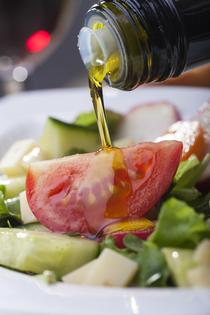Environmental Nutrition: Food synergy boosts nutrition
Pancakes and maple syrup, spaghetti and meatballs, chocolate and strawberries -- these are the "Thelma and Louises" of the food world -- items that just belong together. Beyond flavor, when certain foods are eaten together, their nutritional firepower is amplified. It's called food synergy: a concept where the benefits of two or more foods eaten together can be greater than the sum of their parts. Here's how to harness the power of food-pairing to make your diet extra nutritious and delicious.
Fatten up your salads
Vegetables are already nutritional heavy hitters, but if you really want to reap their rewards, make sure to forgo fat-free salad dressings. A 2017 American Journal of Clinical Nutrition study found that people who consumed salads that included soybean oil improved absorption rates of several key nutrients and antioxidants, including vitamins A, E and K, beta-carotene and lutein, compared to when they munched on salads without oil. Research also shows that other sources of fat, like peanut butter, avocado and whole eggs can increase the absorption of beta-carotene in veggies, such as kale and carrots, which leads to higher levels of vitamin A in the body. So, be sure to serve up vegetables with healthy fat sources, like olive oil, avocado, nuts or seeds.
Tag team your spices
Spices are increasingly lauded for their potential health-boosting powers. But, science shows they work even harder if they don't fly solo. While turmeric is praised for its anti-inflammatory powers, we don't absorb its main bioactive compound, curcumin, well. Yet, a chemical found in black pepper, called piperine, can greatly bolster our curcumin absorption rates. Other research suggests that pairing capsaicin (the phytochemical that gives chili powder its fiery kick) and gingerol (found in ginger) may provide some cancer-fighting properties that are greater than when either is consumed alone. So, remember the spice jars when making dishes like soups, chili, and stir-fry.
Fiber-up your probiotics
You've probably heard that hosting a robust colony of beneficial bacteria is important for digestive, immune and other elements of overall health. And that certain fermented, probiotic-rich foods like yogurt, kefir and sauerkraut offer up a dose of these good-for-you critters. Once the bacteria are in your system, feed them fiber from plant foods so they can thrive. If you include foods containing probiotics in your diet, be sure to eat plenty of fiber-rich vegetables, whole grains, fruits and nuts.
Raise your iron levels with vitamin C
Iron plays a role in transporting oxygen throughout the body so important functions like energy production can occur. Foods like beans, lentils, tofu, fortified cereals, spinach and some whole grains can help keep iron fully stocked. However, the form of iron (nonheme) in these plant-based foods is not well absorbed by our bodies. But Mother Nature has provided an assist in the form of vitamin C (ascorbic acid), which converts plant-based iron into a form that is more readily absorbed. That's why a study in the British Journal of Nutrition found that women who ate iron-fortified cereal with kiwi fruit, which is especially rich in vitamin C, were able to raise their iron levels. Pair iron-containing foods with sources of vitamin C, such as bell peppers, broccoli and citrus.
(Environmental Nutrition is the award-winning independent newsletter written by nutrition experts dedicated to providing readers up-to-date, accurate information about health and nutrition in clear, concise English. For more information, visit www.environmentalnutrition.com.)







